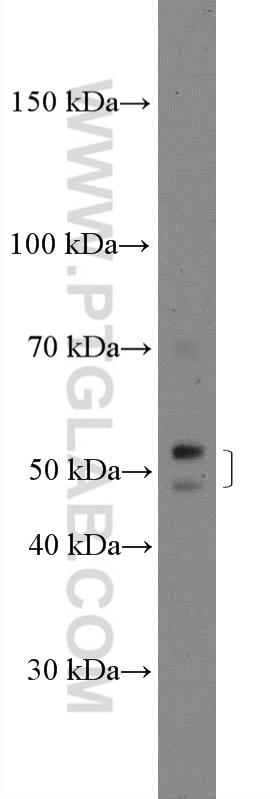Tested Applications
| Positive WB detected in | A549 cells |
Recommended dilution
| Application | Dilution |
|---|---|
| Western Blot (WB) | WB : 1:500-1:1000 |
| It is recommended that this reagent should be titrated in each testing system to obtain optimal results. | |
| Sample-dependent, Check data in validation data gallery. | |
Published Applications
| KD/KO | See 1 publications below |
| WB | See 2 publications below |
| IHC | See 1 publications below |
| CoIP | See 1 publications below |
Product Information
26545-1-AP targets ZDHHC1 in WB, IHC, CoIP, ELISA applications and shows reactivity with human samples.
| Tested Reactivity | human |
| Cited Reactivity | human |
| Host / Isotype | Rabbit / IgG |
| Class | Polyclonal |
| Type | Antibody |
| Immunogen | ZDHHC1 fusion protein Ag24028 Predict reactive species |
| Full Name | zinc finger, DHHC-type containing 1 |
| Observed Molecular Weight | 48-55 kDa |
| GenBank Accession Number | BC021908 |
| Gene Symbol | ZDHHC1 |
| Gene ID (NCBI) | 29800 |
| RRID | AB_2880547 |
| Conjugate | Unconjugated |
| Form | Liquid |
| Purification Method | Antigen affinity purification |
| UNIPROT ID | Q8WTX9 |
| Storage Buffer | PBS with 0.02% sodium azide and 50% glycerol , pH 7.3 |
| Storage Conditions | Store at -20°C. Stable for one year after shipment. Aliquoting is unnecessary for -20oC storage. 20ul sizes contain 0.1% BSA. |
Background Information
Catalog#26545-1-AP recognises 48-55 kDa bands.
Protocols
| Product Specific Protocols | |
|---|---|
| WB protocol for ZDHHC1 antibody 26545-1-AP | Download protocol |
| Standard Protocols | |
|---|---|
| Click here to view our Standard Protocols |
Publications
| Species | Application | Title |
|---|---|---|
Oxid Med Cell Longev Identification of ZDHHC1 as a Pyroptosis Inducer and Potential Target in the Establishment of Pyroptosis-Related Signature in Localized Prostate Cancer | ||
Cancer Gene Ther ZDHHC1 downregulates LIPG and inhibits colorectal cancer growth via IGF2BP1 Palmitoylation
|



